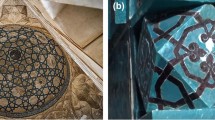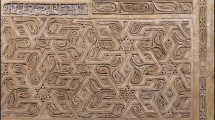Abstract
The Islamic architectural heritage permits us to understand the formation and development of geometric patterns. Many techniques are used to express the patterns related to the forms, and the geometric principles underlying the designs are revealed mainly via compass and ruler. Generally, it is not sufficient to express complex patterns with a single technique, and different methods are used together. In this context, in the analysis of geometric patterns of İzzettin Keykavus tomb, a combined technique using simple drawing tools such as point-joining with the composition technique according to the symmetrical background of the seventeen wallpaper patterns is used. When the created patterns are compared, it is seen that the patterns with similar basic units can differ with the change of symmetry elements.

























Similar content being viewed by others
References
Abas, S. J. and A. S. Salman 1994. Symmetries of Islamic geometrical patterns. World Scientific.
Alani, M. W. H. (2018). Computational investigation of the morphological design dimensions of historic hexagonal-based Islamic geometric patterns. Ph.D. diss., Clemson University
Aslanapa, O. (1993). Türk Sanatı, Remzi Kitabevi. Basım, İstanbul: Remzi Kitabevi
Bier, C. 2015. Geometry in Islamic Art. Encyclopedia of the History of Science, Technology, and Medicine in Non-Western Cultures. https://doi.org/https://doi.org/10.1007/978-94-007-3934-5_10111-1
Bonner, J. 2017. Islamic Geometric Patterns: Their Historical Development and Traditional Methods of Construction. Springer.
Broug, E. 2008. Islamic geometric patterns. London: Thames & Hudson.
Cantay, G. (2002). Keykâvus I Dârüşşifâsı. İslâm Ansiklopedisi: 353–355.
Castera, J. M. 2016. Persian Variations. Nexus Network Journal 18(1): 223-274.
Critchlow, K. (1976). Islamic patterns, Thames and Hudson London.
Cromwell, P. R. 2012. A modular design system based on the Star and Cross pattern. Journal of Mathematics and the Arts 6(1): 29-42.
Demiriz, Y. (2004). İslam sanatında geometrik süsleme: bir envanter denemesi. Istanbul: Yorum Sanat
Diez, E., & Aslanapa, O. (1955). Türk sanatı. Istanbul: İ.Ü. Edebiyat Fakültesi
El-Said, I., T. El-Bouri and K. Critchlow. 1993. Islamic Art and Architecture: The System of Geometric Design. Garnet Pub Ltd.
Gonzalez, V. 2001. Beauty and Islam Aesthetics in Islamic Art and Architecture. Tauris Academic Studies.
Grünbaum, B., Z. Grünbaum and G. Shepard. 1986. Symmetry in Moorish and other ornaments. Computers & Mathematics with Applications 12 (3–4, Pt 2) 641-653.
Grünbaum, B. and G. C. Shepard 1987. Tilings and Patterns. Courier Dover Publications.
Kaplan, C. (2000). Computer generated Islamic star patterns. Bridges mathematical connections in art, music and science. https://archive.bridgesmathart.org/2000/bridges2000-105.pdf Accessed 15 Oct 2021.
Kaplan, C. S. and D. H. Salesin. 2004. Islamic star patterns in absolute geometry. ACM Trans. Graph 23(2): 97-119.
Knight, T. W. 1998. Infinite patterns and their symmetries. Leonardo 31(4): 305-312.
Müller, E. (1944). Gruppentheoretische und strukturanalytische Untersuchungen der maurischen Ornamente aus der Alhambra in Granada. Rüschlikon: Buchdruckerei Baublatt ag
Necipoğlu, G. 1996. The Topkapı scroll: geometry and ornament in Islamic architecture. Sant Monica, CA: Getty Publications.
Ostromoukhov, V. (1998). Mathematical tools for computer-generated ornamental patterns. In Electronic Publishing. Artistic imaging and digital typography. Lecture notes in computer science, Vol. 1375, pp. 193–223. Springer
Öney, G. 1976. Türk çini sanatı. Binbirdirek Matbaacılık Sanayii AŞ.
Önkal, H. (1996). Anadolu Selçuklu Türbeleri. Atatürk Kültür Merkezi.
Özdural, A. 2000. Mathematics and Arts: Connections between Theory and Practice in the Medieval Islamic World. Historia mathematica 27(2): 171-201.
Schattschneider, D. 1978. The plane symmetry groups: their recognition and notation. The American Mathematical Monthly 85(6): 439-450.
Shubnikov, A. V. and V. A. Koptsik. 1974. Symmetry in science and art. Plenum Press.
Sönmez, S. E. (2020). Anadolu Selc̦uklu sanatının geometrik dili: Anadolu Selc̦uklu ve beylikler donemı: geometrik desen analizlerı. Ketebe Yayınları
Sözen, M., & Akşit, İ. (1983). Tarihsel gelişimi içinde Türk sanatı. Istanbul: Emlak Bankasi
Uzunçarşili, I. H., & Edgüer, R. N. (2014). Sivas şehri. (Hazırlayan: Recep Topraklı). Ankara: Türk Tarih Kurumu
Wade, D. 1976. Pattern in Islamic Art. Woodstock, N.Y.: Overlook Press.
Yetkin, Ş. (1972). Anadolu’da Türk Çini Sanatının Gelişmesi. Istanbul: İstanbul Üniversitesi Edebiyat Fakültesi
Author information
Authors and Affiliations
Corresponding author
Additional information
Publisher's Note
Springer Nature remains neutral with regard to jurisdictional claims in published maps and institutional affiliations.
About this article
Cite this article
Özdemir, M., Selçuk, S.A. & Çügen, H.F. The Geometric Patterns of İzzettin Keykavus Tomb. Nexus Netw J 24, 869–895 (2022). https://doi.org/10.1007/s00004-022-00621-z
Accepted:
Published:
Issue Date:
DOI: https://doi.org/10.1007/s00004-022-00621-z




